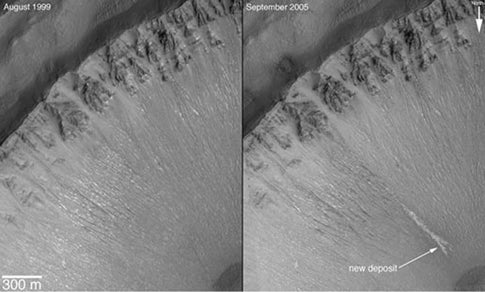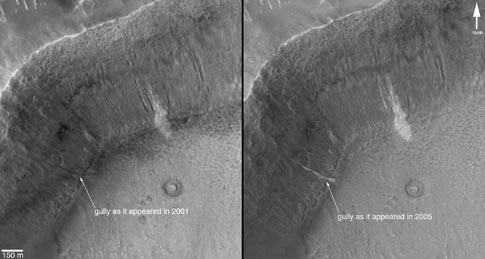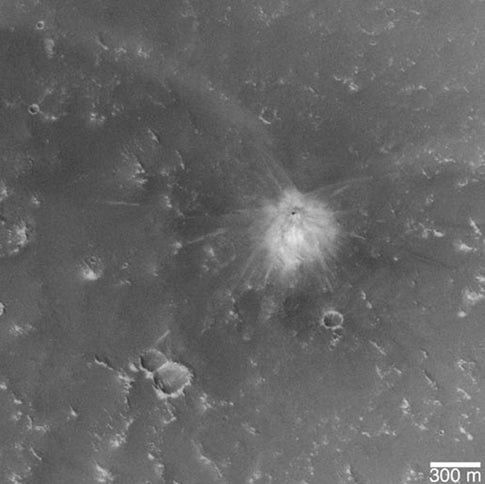Forget about water flowing on ancient Mars — scientists reviewing images from Mars Global Surveyor say it looks like water is flowing there today.
In an astounding discovery that could have implications for how the United States and other countries think about and plan future Mars missions, NASA scientists have found evidence of mud flows that occurred sometime in the past 7 years.
It was Global Surveyors’ 1999 images of gullies etched on martian cliffs that triggered scientists to consider how far back in time water was present on the planet’s surface. At that time, scientists dared to dream that water had flowed as recently as a few million years ago — a blink in geologic time.
Today, however, mission scientists gave an even more evocative conclusion.
“We are talking about liquid water that is present on Mars right now,” says Kenneth Edgett of Malin Space Science Systems in San Diego, California, which built Global Surveyor’s main camera. “No one expected what we found today.”
The evidence is scant — just two of the thousands of gullies Global Surveyor imaged show recent water flow. Nevertheless, the findings could alter NASA’s slow and steady exploration program to follow signs that lead to past water on Mars.
The two sites are inside craters in the Terra Sirenum and the Centauri Montes regions of southern Mars.
The existence of liquid water raises the prospects for past and present-day microbial life on Mars.
Scientists found the water flows by comparing images taken 6 or more years ago with new pictures relayed in the past 2 years. Two gullies show light-colored deposits, which scientists believe to be water that was frozen into ice once it hit the cold martian air.
“Certainly something very remarkable goes on at the mid-latitudes of Mars,” says Arizona State University’s Phil Christensen. “The evidence of liquid water is compelling.”
Mars’ thin atmosphere is too cold for liquid water to exist at the planet’s surface for long. Researchers believe the water burst forth from beneath Mars’ surface and stayed liquid long enough to carry debris down a slope before freezing. The newly formed deposits are each several hundred yards long.
“This wasn’t pure water,” Malin says. “It was probably water with sediment, probably more like a mud flow.”
Scientists also found signs of recent meteorite strikes, a discovery that raises the prospect of another danger for astronauts and future human settlers.
“If you were to live on Mars for 20 years, you’d hear one,” Christensen says. “Is this a hazard for astronauts that we have to consider? The answer is probably yes.”












